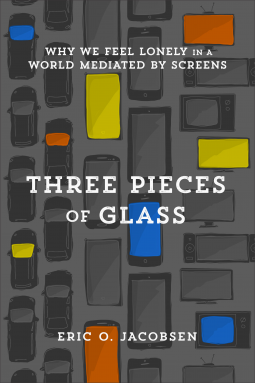
Three Pieces of Glass
Why We Feel Lonely in a World Mediated by Screens
by Eric O. Jacobsen
This title was previously available on NetGalley and is now archived.
Send NetGalley books directly to your Kindle or Kindle app
1
To read on a Kindle or Kindle app, please add kindle@netgalley.com as an approved email address to receive files in your Amazon account. Click here for step-by-step instructions.
2
Also find your Kindle email address within your Amazon account, and enter it here.
Pub Date May 05 2020 | Archive Date Sep 23 2020
Baker Academic & Brazos Press | Brazos Press
Talking about this book? Use #ThreePiecesofGlass #NetGalley. More hashtag tips!
Description
Eric Jacobsen shows how three pieces of glass--the car windshield, TV, and smartphone--are emblematic of significant societal shifts that have created a cultural habit of physical isolation. We feel increasingly disconnected from the people and places around us. Jacobsen explains how adopting everyday practices and making changes in our neighborhoods can help us create a sense of belonging and rediscover what belonging in a place looks like. In order to effectively solve the problem of loneliness, we need to recover patterns and practices of community life that encourage us to form meaningful connections with people and stories that are part of the places where we live, work, and worship. To this end, Jacobsen offers four redemptive strategies for living a more intentional and spiritual life.
Advance Praise
“Eric Jacobsen’s Sidewalks in the Kingdom was transformative for our family. It literally changed the way we walk. I expect Three Pieces of Glass is going to change the way people see—and most importantly, how we see one another. It’s hard to imagine a more timely book for our fractured, lonely republic.”—James K. A. Smith, professor of philosophy, Calvin University; author of You Are What You Love and On the Road with Saint Augustine
“Three Pieces of Glass is a revelatory examination of our human need to belong, showing how this universal desire is a reflection of God’s own nature, his good design, and our ultimate purpose. In these pages, Eric O. Jacobsen points the way past the various fractures and false senses of community that characterize today’s culture in order to help us find—for ourselves and others—true belonging.”—Karen Swallow Prior, author of On Reading Well: Finding the Good Life through Great Books and Fierce Convictions: The Extraordinary Life of Hannah More—Poet, Reformer, Abolitionist
“Eric Jacobsen’s Three Pieces of Glass is a wise and much-needed book, a rich mix of social analysis and theology. Jacobsen offers churches a deep well of imagination for how we can be catalysts of belonging in a world that is dying of loneliness. Three Pieces of Glass is one of the very few books that is both hopeful and helpful for churches as we try to navigate the profound brokenness of late-modern culture, as manifested in our particular places.”—C. Christopher Smith, senior editor, The Englewood Review of Books; author of How the Body of Christ Talks: Recovering the Practice of Conversation in the Church
“Eric Jacobsen is a pioneer in the place-based movement. Three Pieces of Glass is a must read for anyone who cares about their community and their literal neighbors. The four practices that Eric outlines in this book are crucial to experiencing the kind of life that we are yearning to live.”—Dave Runyon, coauthor of The Art of Neighboring
Available Editions
| EDITION | Other Format |
| ISBN | 9781587434228 |
| PRICE | $22.00 (USD) |
| PAGES | 288 |
Featured Reviews
 Sergiu P, Reviewer
Sergiu P, Reviewer
This is an amazing book that every Christian should read. It addresses how 3 technologies have changed the world - The Car, the TV, and the Phone. It talks about the walkability of a neighborhood and it gives practical advice about how to get back some of the community we lost.
 Conrade Y, Reviewer
Conrade Y, Reviewer
Relationship is the glue that bonds a society together. Driven by a desire to belong, we live in a challenging environment to navigate between our inner needs and outer cultural climate. Author Eric Jacobsen calls refers to this as "the crisis of belonging." Why a crisis? It is because of three key challenges or barriers that are keeping people from one another: Relational; Place; and Narrative. Throughout the book, readers will see how these three challenges constantly prevent people from finding their sense of belonging. Written in four parts, Jacobsen skillfully guides us through the reasons why we are increasingly lonely. Beginning with the scene from Cheers where the chorus chimes, "You want to be where everybody knows your name," he paints a picture where we all long to belong. With rising fragmentation of society, the diminishing common spaces to gather, and the loss of a common story that we can share in, it is becoming harder to build relationships. The irony is that, while we all want to have our own private spaces in life, we hide that innate desire in us to want to connect publicly. Jacobsen looks at the problem of relationships and belonging through several different angles.
From a definition standpoint, he gives us the tools of language and the proper vocabulary to pin down exactly what is happening, what we need, and how to go about filling in relational gaps. He defines belonging as a "complex but ultimately coherent phenomenon essential to human thriving." Simply put, what makes it complex is the three key aspects of belonging: Relationship, Place, and Story. What makes it challenging is how to make them all coherent. From a relationship standpoint, we can understand relationships in terms of four levels. Intimate Belonging is most personal with our spouses or perhaps a best friend. Personal Belonging is the kind we have with family and other friends. Social belonging is that kind we experience with others we know fairly well while Public Belonging is about our experience with the rest. We need all four levels of belonging, albeit each at different circumstances. From a Church standpoint, Jacobsen reminds the Church that her call is to be a "sign, instrument, and foretaste" of the gospel. Such a call transcends all of the human relationships we form. In fact, the reason we desire to belong is to be part of the larger context of kingdom belonging. This is so significant that the author dedicates five chapters just to talk about the character, the shape, the differences, and the promise of covenant belonging. Only about halfway through the book, Jacobsen finally reveals what the "three pieces of glass" are all about. In fact, it is about the three technological symbols of car, TV, and the Smartphone. All of them are ubiquitous in their respective eras, the Car culture in the post-WWII era, the TV in the post-Vietnam war era, and the Smartphone in the Millennium. In fact, these three pieces of glasses are metaphors to describe how the technological age has challenged the age-old need of people to belong. They have become the very things that divide us, separate us, and keep us apart. Far apart. Not only do they increase our productivity, they also increase our propensity to be constantly busy. They feed on one another to worsen any state of loneliness. Jacobsen also cautions us on jumping in with inappropriate solutions. Solutions such as consumerism. For relationships cannot be resolved simply by throwing money at them.
Cars can bridge distance but they cannot necessarily bridge relationships. Smartphones help us connect from a distance but they distance us from people near us. Yet, Jacobsen poses a very interesting question: "Despite growing concern about it, why is smartphone use continuing and even growing?" Perhaps, it is habitual. Taking the observations of James KA Smith, Jacobsen uses the metaphor of the mall as a way to describe the effects of consumerism. The last part of the book is dedicated to putting forth ideas on how to live more intentionally with relationships and holistic belonging in mind. In design, we can find creative ways to ease community living. In proximity, we think of ways to put connectivity primary, and convenience secondary. In placemaking, we create spaces for interaction. In local culture, we encourage the sharing and telling of stories.
This is a very intelligently written book, full of metaphors and insights into our modern way of life. There are always multiple layers of understanding which the author clearly and carefully peels away to show us the root of the issue. Issues such as the different levels of relationships to help us decide which and how to spend our limited time and resources on. Of course, there are limitations to such a model due to the different contexts and the unique personalities. Plus, what is public now may become private overnight. Sometimes, relationships do become social or personal depending on the different roles and circumstances. What I like is the way Jacobsen takes the metaphors of visible objects like cars, TV, and Smartphones to drive home the problem of loneliness and our need for belonging. They also highlight the irony of life. With the rise in our standard (and cost) of living, we give up something much more valuable: Relationships. In fact, the author is quite brilliant in how he sets the stage first to present the problem. Like peeling an onion, with each layer removed, he exposes the innermost tears of desires in our hearts to connect and want to connect. We have substituted community for convenience; common interests with individualistic preferences; and common places for private spaces. If we do not take notice and modify our choices, we might not just be isolating ourselves into oblivion, we would also be digging our own graves of loneliness.
This book is a wake-up call that says our relationships are at stake. We need to pay attention to the very things that are dividing us before it is too late.
Eric O. Jacobsen is senior pastor of First Presbyterian Church in Tacoma, Washington, and teaches at Fuller Theological Seminary.
Rating: 5 stars of 5.
conrade
This book has been provided courtesy of Baker Academic and NetGalley without requiring a positive review. All opinions offered above are mine unless otherwise stated or implied.
A recent commercial for a pizza chain reprises a classic TV scene in which a figure of a somewhat heavy set man who walks into an establishment. In the classic version, he is instantly recognized and everyone calls out “Norm.” In the contemporary version, no one knows his name because he hasn’t created an online profile tracked on his phone. In the old neighborhood bar, “everybody knows your name.” Now belonging is increasingly mediated through a screen.
Eric O. Jacobsen didn’t anticipate the commercial, which underscores the theme of belonging represented by Norm that runs through this book. He contends that three pieces of glass, the windshield of the automobile, the screen of the television, and the screen of our smartphones, tablets, and computers have fundamentally influenced our experience of belonging in society.
Jacobsen begins his discussion by exploring the nature of belonging as having to do with relationship, place and story, and levels of belonging from intimate and personal to social and public and how intimate and personal are not enough. He explores the way in which experiences of social and public, together referred to as civic belonging, offer foretastes of kingdom belonging.
The second part of the book then sketches out the nature of kingdom belonging which he characterizes as unconditional, covenantal, invitational, compassionate, diverse, transformative, delightful and productive. He contrasts this with worldly belonging and highlights the inclusive (the images of the feast and the table) and the covenantal relationship character of the kingdom.
Part three considers the gospel and belonging and shows how through the gospel, broken relationships are restored and there is healing for the epidemic of loneliness. For people who feel estranged and exiled, there is a promise of homecoming. And for those living in a story of meagre existence, there is a better and grander story.
The fourth part of the books addresses how the “three pieces of glass” have contributed to our crisis of belonging. The automobile has changed how our living spaces have been configured, from the design of our homes, to the walkability of our neighborhoods, and the location of where we shop and work in relation to where we live. Television changes how we view real people versus our “TV friends.” Our smartphones and other devices have led us to substitute virtual for face to face interaction. These have led erosion in the civic realm and an epidemic of “busyness.
The last two parts consider, first, the influence of our choices on our communal life, our public policies, and on our liturgical life and second how we may encourage belonging. The last part reprises ideas elaborated at greater length in Jacobsen’s earlier books, Sidewalks in the Kingdom and The Space Between, both influenced by the new urbanism. He looks at the design of our communities, advocating for walkability, our proximity, which includes a parish vision for the church, the making of meaningful public places, and a local culture reflected in language, shared stories, and events.
Writing this review during the Covid-19 pandemic gives me a different perspective on this book than I might have had during “normal” times. The latter two pieces of glass have taken on critical importance both as sources of information (although we have to watch for media overload), and as the one means of connection, or belonging most of us have when we must practice physical distancing–particularly in connecting with family, friends, our church community, our work colleagues, and even our political leaders. For many of us, we can work from home (and this may not even represent a change for some of us.)
By the same token, people are walking their neighborhoods at safe distances, in some cases meeting neighbors they never knew by name. I know of one neighborhood where a local folk singer set up in his front yard and staged an impromptu singalong. When we can’t go to restaurants, sporting events, and many of the other places our cars take us–we are left with walking and a kind of “neighboring” occurs. By the same token, I wonder if fights would have occurred over essential goods in the neighborhood markets I grew up with that occur in our megastores where people come from miles around and it is rare you meet someone you know. You shopped with people you knew in those neighborhood groceries and, perhaps we would be more considerate of the needs of others and neither hoard nor fight. After all, we lived with those people and we would be publicly shamed if we took more than our fair share!
Jacobsen’s book makes me wonder whether we will be more mindful about this question of belonging, as we realize how dependent we are upon both in our churches, and in the civic sphere. It makes me wonder if we will take a fresh look at our neighborhoods, both what is good about them, as well as what could be better about our places, and how we connect with each other. With internet connected devices, I suspect it is a bit more complicated. It would not surprise me if life becomes more oriented for more people around these devices. We are doing more education through them, more commerce, more business collaboration, and even more religious activity. While we discover that the church is not a building, will we also jettison the physical encounters that are at the heart of Christian community, from the breaking of bread and the cup to all those meals and potlucks that are some of the best part of our lives? Even before this crisis, I was in conversation with those who talked about declines in church attendance, in which someone pointed to their smartphone and said, “that’s because many think they carry church in their pocket.”
Yet Jacobsen reminds us of our epidemic of loneliness. He raises the critical question of whether belonging can be mediated through a smart device, or whether the proximity necessary for social and public belonging can be created in a car culture. We may love our TV friends, but will they love us back? Jacobsen’s book raises a series of inter-related questions for how the church understands its message, how we steward our technology, and how we configure the places where we live. How we answer those might well make the difference between places where nobody or everybody knows our names.
________________________________
Disclosure of Material Connection: I received a complimentary review copy of this book from the publisher via Netgalley. The opinions I have expressed are my own.
 Reviewer 627462
Reviewer 627462
I found this book to be really interesting and a different take on mental health, especially prevalent at the current time.
Thank you to NetGalley for providing me with an advance readers copy in exchange for an honest review.













